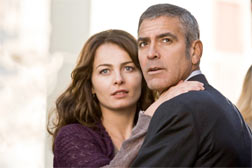The Really Quiet American
George Clooney in a contemplative spy thriller.
After you've seen The American, check out our Spoiler Special discussion:
You can also download the program here, or you can subscribe to the Spoiler Special podcast feed via iTunesor directly with our RSS feed.
The American (Focus Features), the second film by the Dutch photographer-turned-filmmaker Anton Corbijn (Control), is like a James Bond fantasy for very patient Europhiles. The story, loosely based on a novel by Martin Booth, contains gunplay, exotic locations, and a bevy of international beauties throwing themselves at a hunky hit man. But all of these elements are suspended in a medium of near-motionless anomie that recalls the austere thrillers of Jean-Pierre Melville or, at times, the existential longueurs of Antonioni. If you're willing to let go of your Hollywood-bred expectations for a movie of this type—spectacular action set pieces, constant pulse-pounding music, a killing every 15 minutes— The American is a great pleasure to watch, an astringent antidote to the loud, frantic action movies that have been clogging our veins all summer.
For all the demands it will place on the viewer's attention span, though, The American doesn't start slow. It kicks off with an absolutely killer cold open in a snowbound cabin in Sweden, where the American of the title, Jack (George Clooney) is romancing a lissome Scandinavian honey. Their postcoital stroll turns unexpectedly violent—a development that's all the more frightening for taking place in absolute, snow-muffled silence. Jack goes into hiding in Italy, instructed by his superior Pavel (Johan Leysen) to lie low for a while. (We never do learn exactly what kind of organization Jack works for—is he a CIA agent? An international operative of some kind? A mercenary?) A tiny hillside village in Abruzzo becomes Jack's temporary home. Again on the instructions of the mysterious Pavel, Jack—who, apparently, is a world-class gunsmith—begins working on a special custom-designed weapon for a female assassin (Thekla Reuten).
Slate V: The American
The entire middle section of the film consists of long scenes of Jack alone in his pensione, machining gun parts. For recreation, he drinks brandy with the local priest (Paolo Bonacelli) and seeks the favors of a prostitute, Clara (Violante Placido). This part of the movie may lose many viewers: Hey, I didn't pay 12 bucks for a George Clooney spy movie so I could watch the man sit silently in front of a lathe! But Corbijn's bare-bones reduction of the spy genre to its constituent parts has its own dry, spare charm. By the time that gun is finally built, we know a lot more about Jack's character than we did going in, and we're keen to see what the weapon will eventually get used for.
Given that—even in character as a gaunt, brooding, emotionally remote assassin—George Clooney is George Clooney, Clara the prostitute soon falls in love with him. (It doesn't hurt that he uses his brothel time to give her sexual pleasure.) The prospect of a new life with this adoring, implausibly softhearted young woman begins to crack Jack's shell, and he entertains the possibility of retiring from the business after he finishes this one last job ….
It's a testament to Corbijn's directorial gifts that a movie featuring "one last job," a taciturn loner, and a hooker with a heart of gold could feel as crisp and unusual as The American. Corbijn's aesthetic choices are consistently unexpected: He films the Italian hill town where Jack holes up not as an Under the Tuscan Sun-style postcard, but as an intriguing set of geometric patterns. And Lord, what a relief to watch a movie, thriller or otherwise, that isn't scored to within an inch of its life. (When it does appear, the music, by Herbert Gronemeyer, is appropriately contemplative.)
Though it doesn't add up to a lot more than a taut little exercise in style, The American does provide ammo—finely machined custom-built ammo—against those who find Clooney a one-note actor, coasting along on his Danny Ocean charm. This role isn't exactly a stretch for Clooney, but it's a more somber and nuanced extrapolation of the part he played in Michael Clayton and Up in the Air—the self-contained, hypercompetent loner who can't be tied down to one town, one job, or one woman. As happens with movie stars—Jennifer Aniston, Angelina Jolie—Clooney's archetypal role is also inevitably inflected by what we know about his real-life persona. Maybe his career as an actor won't be about escaping that archetype but about refining and exploring it, the way Clint Eastwood has done. Sergio Leone is an explicit reference in The American: In a bar, a TV plays a scene from Once Upon a Time in the West, and the final shootout on the winding medieval streets of the village has a Leone-esque purity. It's easy to forgive The American its flaws (for fear of spoilage, I'll just say two words: butterfly symbolism) if you take it as a latter-day, Zen spaghetti Western, with Clooney as the Man With No Name.

